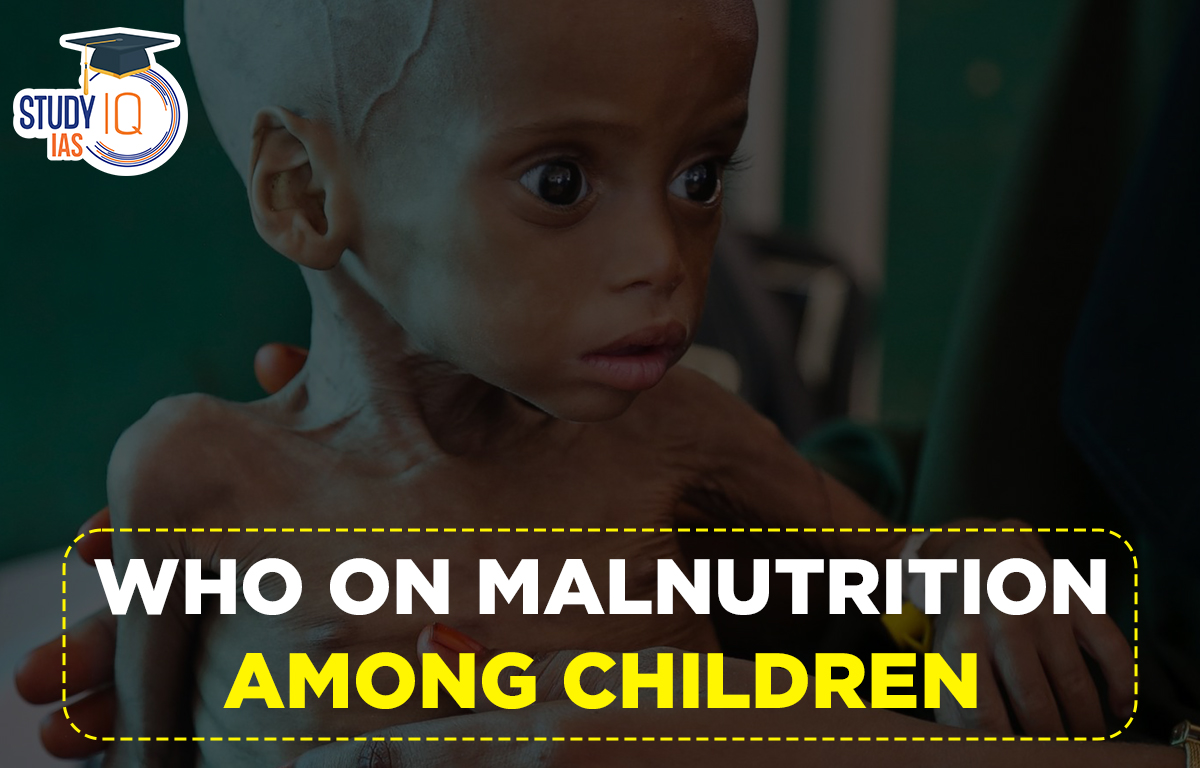Table of Contents
In News: World Health Organization (WHO) in its January press brief called for protecting children suffering from acute malnutrition.
WHO on Malnutrition Among Children Background
- According to the State of Food Security and Nutrition in the World report (SOFI, 2022), the number of people affected by hunger globally rose to as many as 828 million in 2021, a 150 million increase since the outbreak of the COVID-19 pandemic in 2019.
- India and Malnutrition: India’s child malnutrition rates are one of the most alarming in the world.
- According to NFHS, conducted in 2015-2016, prevalence of underweight, stunted and wasted children under five was at 35.7, 38.4 and 21.0 per cent.
- The Global Hunger Index (2021) — calculated on the basis of total undernourishment of the population, child stunting, wasting and child mortality — places India at the 101st spot among 116 countries.
- The bane of child and maternal malnutrition is responsible for 15 per cent of India’s total disease burden.
Wasting or Acute Malnutrition
- It is a form of undernutrition caused by a decrease in food consumption and/or illness that result in sudden weight loss.
- Children with acute malnutrition have low weight for height.
- They may have nutritional oedema and other related pathological clinical signs.
- They have weakened immune systems and are at higher risk of dying from common childhood diseases.
- Child wasting (defined as low weight for height) is the most dangerous form of undernutrition.
- Severe wasting is the deadliest form, as severely wasted children are 12 times more likely to die than a well-nourished child.
Highlights of WHO Brief
- Currently, more than 30 million children in the 15 worst-affected countries suffer from wasting (acute malnutrition).
- 8 million of these children are severely wasted, the deadliest form of undernutrition.
- Reasons: Conflict, climate shocks, the ongoing impacts of COVID-19 and rising living costs are leaving increasing numbers of children acutely malnourished.
- Lack of access to critical health, nutrition and other life-saving services are becoming less accessible.
- Vicious cycle: Malnutrition leads to disease, and disease leads to malnutrition,
Way Forward
- Global support: Urgent support is needed now in the hardest-hit countries to protect children’s lives and health.
- This includes ensuring critical access to healthy foods and nutrition services, especially for women and children.
- Priority actions: Five priority actions that will be effective in addressing acute malnutrition:
- Enhancing analysis of the determinants of child wasting.
- Ensuring essential maternal and child nutrition interventions.
- Increasing availability, affordability and access to healthy diets.
- Introducing specialised nutritious food products.
- Fostering a protective environment by ensuring joint nutrition.
- Accelerated progress on the Global Action Plan on Child Wasting: It aims to prevent, detect and treat acute malnutrition among children in the worst-affected countries.
- Countries: Afghanistan, Burkina Faso, Chad, the Democratic Republic of the Congo, Ethiopia, Haiti, Kenya, Madagascar, Mali, the Niger, Nigeria, Somalia, South Sudan, Sudan and Yemen.
Steps Taken in India to Fight Malnutrition
- Integrated Child Development Services (ICDS)
- It facilitates a supplementary nutrition programme, growth monitoring and promotion, nutrition and health education, immunization, health check-ups and health referrals, as well as pre-school education.
- Beneficiaries are children below five years, as well as pregnant and lactating women.
- POSHAN Abhiyaan
- It is a flagship national nutrition mission to improve nutrition among children, pregnant women and lactating mothers in 2017.
- Aims: To reduce malnutrition among children by facilitating inter-departmental convergence, real-time monitoring, intensified health and nutrition services for the first 1,000 days and Jan Andolan (community Mobilization).
- Saksham Anganwadi and Poshan 2.0
- It is an Integrated Nutrition Support Programme.
- Aim: To address the challenges of malnutrition in children, adolescent girls, pregnant women and lactating mothers through a strategic shift in nutrition content and delivery and by creation of a convergent eco-system to develop and promote practices that nurture health, wellness and immunity.
- Objectives of Poshan 2.0 are:
- To contribute to human capital development of the country;
- Address challenges of malnutrition;
- Promote nutrition awareness and good eating habits for sustainable health and wellbeing;
- Address nutrition related deficiencies through key strategies.


 Daily Quiz 11 July 2025
Daily Quiz 11 July 2025
 Operation Baam: Baloch Separatist Group ...
Operation Baam: Baloch Separatist Group ...
 Article 326 and Electoral Roll Revision ...
Article 326 and Electoral Roll Revision ...





















